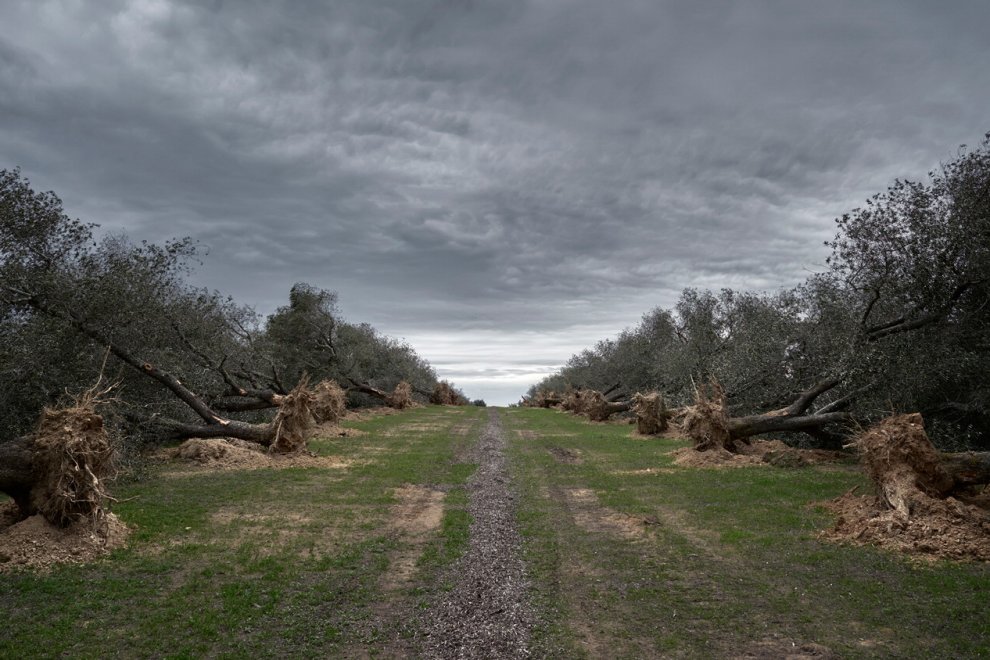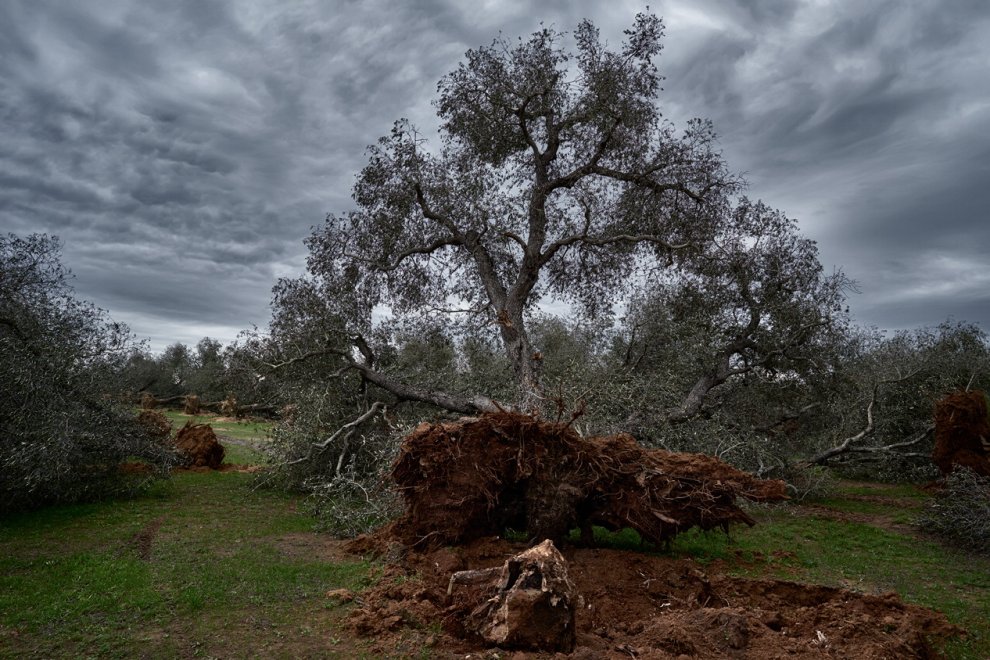Xylella bacteria, olive trees and bad politics
Italy The olive groves of Puglia (Apulia) that give southern Italy its history and culture are at risk of demolition. But is it a tree bacteria or greedy developers who are killing them?
 Torchiarolo (Brindisi, Apulia), 2015 – Vincenzo Rapanà
Torchiarolo (Brindisi, Apulia), 2015 – Vincenzo RapanàItaly The olive groves of Puglia (Apulia) that give southern Italy its history and culture are at risk of demolition. But is it a tree bacteria or greedy developers who are killing them?
At Torchiarolo, in the province of Brindisi, the stems of ancient olive trees intertwine and create shapes that have nothing to envy of Rodin sculptures. Behind this landscape of centuries-old giants that attract the attention of foreigners and tourists, there is an olive economy spanning from Santa Maria di Leuca to Torre Maggiore. It generates €492 million a year, the equivalent of 35 percent of the national production of olive oil and equivalent to 183,000 tons for 190,000 companies.
The olive trees planted by the ancient Messapi in the eighth century BC, in addition to being a landscape resource and a green lung that enhances the charm of the peninsular heel, are a vital economic resource, a heritage that has always guaranteed “autonomy” and “self-sufficiency,” but also a “pace” in the deeply Southern lifestyle of production as slow as the olive requires.
We know, however, that these heritages do not fit well in the context of a globalized economy, committed to the radical division of production and consumption areas to better manage price and market trends. So also in Apulia (Puglia), on the fence between local bad politics and globalization, it is asked to sacrifice part of its own identity.
The ruin of arable lands, polluted by the fumes of the steelyards, is caused by a plague unknown within the European Community: The Xylella fastidiosa, a phytopathogen bacteria that, according to experts, clogs the xylematic vessels, that is, the “pipes” that carry the sap from the roots to the leaves of the olive tree, and causes a browning of the foliage. These symptoms of CoDiRO (olive tree quick desiccation syndrome), however, have always been attributed to other factors: moths, fungi, or the improper use of pesticides and herbicides.
More generally, however, the olive groves have been neglected. This figure has not affected the opinions of the National Research Council, or CNR, and the University of Bari, which have blamed the CoDiRO, without much scientific certainty, on the Xylella fastidiosa, the bacteria included in the list drawn up by the E.U. on quarantine pests. Its presence on Italian soil, in fact, activates a series of procedures — largely economic — to comply with its purge. Behind the precautions taken, funds and reimbursements are allocated by the governments and institutions responsible for monitoring and analysis of samples. About €269,000 have already been paid to the National Research Council in Bari, but most of the money, however, goes to ARIF — Regional Agency for Irrigation and Forestry Resources, a company owned by the region and always at the center of debate for waste and gilded useless consulting.
–> See the disaster with your own eyes (bari.repubblica.it)

The financial taps are opened without any certainty, and the European Food Safety Authority reports that “there is currently no scientific evidence proving that some fungi, rather than the Xylella fastidiosa bacteria, are the primary cause of the olive tree quick desiccation syndrome.” The situation looks very different compared to the state emergency invoked by the authorities, when we think it is only 1.8 percent of the trees on which the Xylella bacteria was found, that the effective desiccation is being static and not expansive, rather more patchy than like wildfire. It is therefore believed that the CoDiRO be attributed to a synergy of contributing factors and not to the Xylella bacteria by itself.
More and more, farmers and scholars are giving new life to those olive trees branded by the forest rangers as infected. They apply traditional methods, with organic fertilizer, copper, zinc, lime and careful pruning. And there is the very recent testimony of professors Antonia Carlucci and Francesco Lops, after five months of experiments on infected trees, financed by Copagri (Confederation of Agricultural Producers): “The leaf count and the evaluation of the chlorophyll index have shown that plants have overcome the presence of the bacteria and are able to survive,” proving that the Xylella does not cause the death of the olive tree, but it coexists with it.
Meanwhile, while the research is ongoing, the tree cuts began last February, when Agriculture Minister Maurizio Martina appointed Giuseppe Silletti, former commander of the Forest Service of the Puglia region, as extraordinary Technical Commissioner. The commissioner submitted a containment plan to stop the Xylella emergency to the Civil Protection Department. The Silletti plan, confirmed in September — which included compensation for individuals willing to cut their olive trees — provided for the destruction of infected trees and those found within a radius of 100 meters (after an appeal to the Regional Administrative Court, however, the plan was amended and limited to cut only infected trees), and intensive monitoring, the elimination of herbaceous weeds using herbicides, and the application of insecticide treatments.
Speculation about an agriculture mafia shadows this emergency maneuver. The amendment put forward by Councillor Sergio De Blasi of the Democratic Party — which makes the land affected by the bacteria unsuitable for construction for 15 years — and approved by the Agriculture Committee, still leaves some doubt. In fact, the document states that the land where Xylella-affected trees have been felled is not suitable for construction, whether the trees were ancient or not. But since the CoDiRO has not been attributed yet to this bacteria, if there is ever a retraction and the blame falls back on fungi or other pathogens, then nothing would prevent the casting of concrete.
And there is also the fear that the amendment would be annulled well before the 15-year period (with a typical Mid-August Ferragosto coup), so as to open a gold rush in the area.
In addition, the law includes a clause that does not preclude any “public works necessary to protect public safety and the environment.”
Along with resorts and tourist villages, even the TAP (Trans-Atlantic Pipeline) comes into play. The 870-kilometer pipeline will go ashore in San Foca (Marina di Melendugno) carrying 10 billion cubic meters of gas from Azerbaijan into Europe for 50 years. In addition to the latter, as reported by Coldiretti-Eurispes, there is an interest by the authorities for the widening of the SS275 highway from Maglie to Leuca “tearing apart 15,000 olive trees.” Let’s now imagine these lands freed from the stems of the olive groves, they may accommodate many other more profitable and intensive crops, to the delight of big landowners and multinationals.
The people of Puglia, however, are not indifferent, and they are organizing.
Associations, committees and free citizens have put aside their political inclinations under the banner of the “People of the Olive Trees” and are roaming the cities informing the local people of what is happening. Through synergy between the legal route and radical fight, they submit appeals to the Regional Administrative Court and occupy spaces in the area, aware that their presence can stop the axe. In opposition to the indifferent intellectual class that attempts the forced recovery of the Pasolini philosophy, 40 years after his death, there is a part of the population that resists the limitation of their rights, showing a strong atavistic political awareness that Puglia had already demonstrated in 1949.
Like the Arneo laborers, who fought against the landowners for the granting of uncultivated land, today farmers together with activists of associations, without paying tribute to Pasolini, echo their civil commitment as stewards, this time as material safekeepers, of an endangered “land of work.”
–> Originally published in Italian at il manifesto on Nov. 25 2015
I consigli di mema
Gli articoli dall'Archivio per approfondire questo argomento
